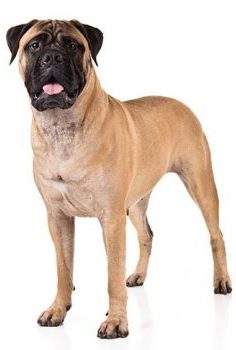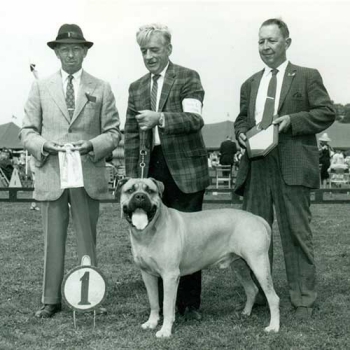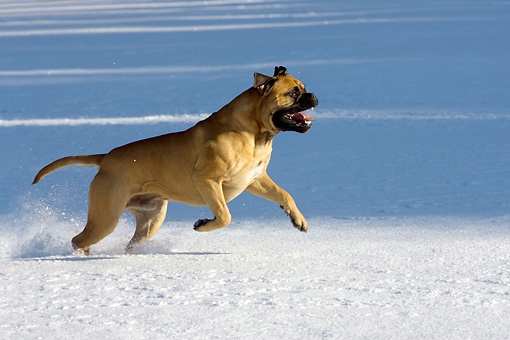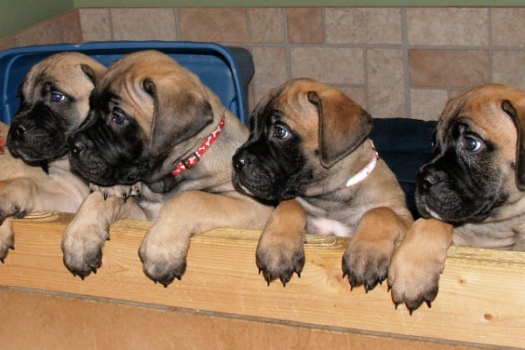Popularly knower as “The Gamekeeper’s night dog”, a Bullmastiff is strong, firm and fearless. He is a large brave dog who is very affectionate towards his owners but is a little standoffish towards strangers.
It is believed that Bullmastiffs are a cross between a Bulldog and a Mastiff.
The dogs have dark eyes, high-set V-shaped ears, and a broad, deep muzzle which distinguish it from all the other breeds.
Bullmastiff Breed Overview

| Group: | Working Group |
| Size: | Extra large (100 to 130 pounds) |
| Lifespan: | 12-16 Years |
| Best Suited For: | Families |
| Temperament: | Docile, Reliable, Alert, Reserved |
| Exercise Needs: | Low to Moderate |
| Drooling Potential: | High |
| Grooming Needs: | Low |
| Similar Breeds: | Great Swiss Mountain Dog, Komondor, Kuvasz |
1. Basic Features
Bullmastiffs are strong and confident. They are about 24-27 inches tall and weigh about 100 to 130 pounds. They are acceptable in fawn, red and brindle colors and a little white marking may appear on their chest.
Bullmastiffs are working breeds which are bred mainly for their strength, size, and speed. They are generally guarding dogs and are devoted to their family. A Bullmastiff is not much of a barker and is ideal for an apartment despite his size.
A Bullmastiff’s coat is short and smooth and doesn’t require frequent maintenance. A quick brushing is enough to get the dead hairs out and reduce shedding.
2. Bullmastiff Origin

The Bullmastiffs originated in the mid 19th century in Britain. They were bred and used to hold off poachers to help gamekeepers protect the game on the estate. They experimented with many breeds in order to create the perfect dog and ended but creating a Bullmastiff which was a mix between a mastiff and a bulldog.
This thus came to be known as the “Gamekeeper’s Night-Dog and worked with the gamekeeper. They lived with the gamekeeper and his family. They preferred the dark brindle color as it served as a camouflage, especially at night.
After poaching slowly came to a decline, the bull mastiff started to be used as a guard dog. Soon after the Bullmastiff began to e bred as a distinct type and not as a crossbreed.
3. The Personality of a Bullmastiff
This sweet family dog is fearless yet serving as a great guard. They are obedient and love their family. They are loyal and good-natured but can be aggressive around strangers. It is thus not advisable to leave your dog off-leash or take him to dog parks.
Bullmastiffs are intelligent and are independent thinkers.
4. Bullmastiff Behavior
As Bullmastiffs were bred to be watchdogs who were silent, they don’t have a barking problem!
They are loving, but may not be very friendly with strangers. This makes them a little dangerous and thus require early socialization. If the dog is exposed to different people, situation etc. from an early age, they grow up to be well behaved.
The may get a little aggressive if they sense a threat to their family. Therefore, it is very important to raise him to be docile and easygoing.
5. Exercise Requirements

Bullmastiffs are low energy dogs and do not require a very high amount of exercise. A walk and outdoor plays must be enough for the dog’s need.
An outdoor yard is a perfect play space for a Bullmastiff. However, it is important that the yard is fenced.
Moderate exercise should do well with the dog. It is important that the dog is not over-exercised, especially as a pup.
6. Diet Needs
Large breed dog food or even adult dog food is recommended for a Bullmastiff puppy so as to ensure a growth which is slow yet steady. Several small meals are advised for a puppy and two meals a day are great for an adult dog.
Exercise is not recommended before and after eating due to a risk of a bloat.
It is important to keep the Bullmastiff puppies lean due to the fact that their growth is very rapid.
7. Trainability
It is important to start training your puppy as soon as he is brought home. Socialization classes are important as a Bullmastiff may not be very friendly with other dogs.
A Bullmastiff is very important so being consistent while training is important. No physical punishment should be given and encouraging the dog at every step might work great.
A Bullmastiff, however, may not require a special guard training as they are great guard dogs since birth. They have natural guard instincts to protect their family.
8. Common Health Problems
Generally considered healthy, a Bullmastiff may have a few genetic health conditions. Hip dysplasia, elbow dysplasia, cancer, and bloat are common health problems which may occur in a Bullmastiff.
Most of the health conditions may not even occur during puppyhood. It is important to ask your breeder about these conditions. Test results of the common health conditions should be submitted beforehand.
These conditions may be genetic but you can protect your dog from a common health condition which is obesity. Keep your dog healthy and fit by giving him proper food and a moderate exercise.
9. Who should Adopt a Bullmastiff?

A Bullmastiff is a perfect protector and a loving companion. He loves his family and is also independent,
Though they are great for everyone, Bullmastiffs are more preferable for people who need a guard for their home.
A house with a fenced yard is preferred for the dog. However, he is said to be adaptable and adapts to any house condition.
Though they are independent, they require a proper training and their owners time. Keeping these things in mind would help you decide whether a Bullmastiff is a right companion for you.
